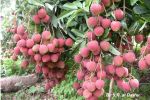
The litchi is one of the special treasured fruit which is unique to China. During the Tang dynasty in China there was a most beautiful courtesan who loved to eat this delicate fruit. A special Chinese pony express was catered to her needs traveling 3 days to specially transport the fruit from the orchard straight to her table in the capital city thousands of miles away. The lychee has a distinctively fresh and fruity taste with high nutritional value and is one of the most popular delicacies in the Orient.
Taiwanese litchi are succulent with tender flesh, bursting with juice and fresh aromatic sweetness. It is best eaten right away when the flesh of the fruit is still milky white in a moonlight translucency. The harvest season is generally in the summer months of June and July and is completed in a short period of two weeks. Although the harvest season is very short, the quality of the fruit is at its optimal and the duration of the harvest season ensures a fair market price for consumers.
There are over one hundred varieties of litchi and more than 20 different cultivators in Taiwan alone. Most farmers distinguish the fruit by their varied characteristic size, color, and flesh textures resulting in popular range of names such as Silk Brocade Purse, Midnight Leaves, Bamboo Noir, Sticky Rice, Cassia, Watermelon Sandy Basin, March Rouge, Summer Heat and Port Vistas (or, portviews) to name a few. Most production in Taiwan currently consists of the Midnight Leaves variety which has a market share exceeding 80%, while the Silk Brocade Purse variety enjoys approximately 10% of the market share. The remaining litchi such as Sticky Rice, March Rouge (kiss of Spring), Cassia (kiss of Cinnamon), Seaport, Sandy basin, Portview, Kaohsiung Early Sunrise and Redskins make up the rest of the litchi market. The Silk Brocade Purse and the Stick Rice have a thinner skin while the flesh of the fruit remains large and succulent and extremely desirable and sought after!
Since the litchi is difficult to maintain fresh without refrigeration and when production exceeds seasonal demand the excess is packaged in cans or processed into dried fruits. Taiwan litchis are exported mainly to the US and Canada.
Preparation / Usage
Peel away the rough outer skin of the fruit, and consume the flesh inside which is a ball the size of a ping-pong with a small seed the size of an M&M's chocolate coated peanut candy at the center, then eat the fruit fresh or produce juice, dried fruit, canned fruit, or fruit liqueurs, etcetera.
Production Season
Summer from May to August.
Cultivation Regions
Kaohsiung, Taichung, Nantou, Tainan, Changhwa, and Ping-T'ung.

